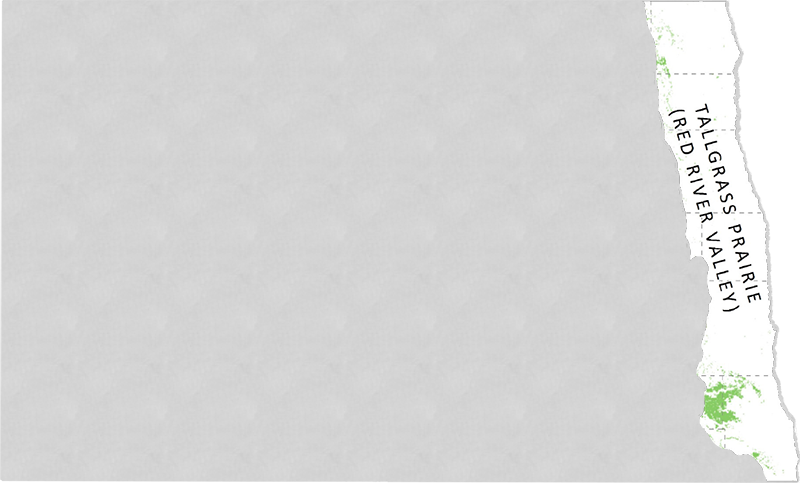
Tallgrass Prairie (Red River Valley)
Area: 4,464,000 acres or 6,975 mi²
Description and Overall Condition: This landscape component consists of the tallgrass prairie historically found predominantly in the eastern one-fourth of North Dakota. The Red River of the North forms the state line between North Dakota and Minnesota. This region today is commonly referred to as the Red River Valley. 10,000 years ago, a large glacial lake named Lake Agassiz covered this region.
The flat topography and rich soil of the glacial Lake Agassiz basin provides for excellent but intensive agricultural production including potatoes, beans, sugar beets, corn and wheat. By the 20th century, much of the tallgrass prairie had been converted to farmland. Few tracts of native vegetation remain in this region today. Places where small natural areas remain intact are remnants of Lake Agassiz. The shoreline of Lake Agassiz created diagonal striations of sand and gravel a few feet high that are still visible in aerial and satellite imagery today. These beach ridges are one component of the focus area “Sand Deltas and Beach Ridges” in conjunction with several large fan-shaped deltas of sand formed from Agassiz. Saline areas of unsuitable farmland due to the high salt concentration of the soil remain intact. The largest continuous area just west of Grand Forks is also a focus area, the “Saline Area” or sometimes referred to as Grand Forks County Prairie. The Red River Valley has few wetlands compared to the mixed-grass prairie to the west. Farmland with woodlot and shelterbelt plantings is now prevalent throughout the region, however, advances in farming practices are resulting in the removal of shelterbelts. Several streams important to native fish meander across the Red River Valley, from west to east, draining into the Red River.
Predominant Natural Vegetation
Grasses: big bluestem, little bluestem, switchgrass, Indiangrass, prairie dropseed, slender wheatgrass, porcupine grass, mat muhly, fescue sedge, meadow sedge
Forbs: western prairie-fringed orchid, blue-eyed grass, meadow anemone, prairie cinquefoil, wild licorice, prairie blazing star, tall goldenrod, black-eyed susan, white sage
Associated Species of Conservation Priority
Birds: American bittern, northern pintail, northern harrier, swainson’s hawk, american kestrel, sharp-tailed grouse, greater prairie-chicken, yellow rail, willet, upland sandpiper, marbled godwit, wilson’s phalarope, short-eared owl, grasshopper sparrow, le conte’s sparrow, nelson’s sparrow, dickcissel, bobolink, western meadowlark
Mammals: pygmy shrew, arctic shrew, plains pocket mouse, richardson’ ground squirrel, eastern spotted skunk, gray fox
Insects: canadian toad, northern prairie skink, plains hog-nosed snake
Reptiles/Amphibians: dakota skipper, poweshiek skipperling, monarch butterfly, regal fritillary
Other Characteristic Wildlife
Birds: mallard, blue-winged teal, red-tailed hawk, American kestrel, ring-necked pheasant, killdeer, Eastern kingbird, Western kingbird, American crow, common yellowthroat, clay-colored sparrow, vesper sparrow, Savannah sparrow, Henslow's sparrow, Western meadowlark, brown-headed cowbird.
Mammals: Northern short-tailed shrew, white-tailed jackrabbit, snowshoe hare, Franklin's ground squirrel, thirteen-lined ground squirrel, Northern pocket gopher, plains pocket gopher, Western harvest mouse, deer mouse, Northern grasshopper mouse, prairie vole, meadow vole, meadow jumping mouse, Western jumping mouse, coyote, red fox, raccoon, badger, striped skunk, white- tailed deer, moose
Reptiles/Amphibians: American toad, Great Plains toad, Northern leopard frog, chorus frog, tiger salamander, plains garter snake, common garter snake
For more detailed information about this topic, please see the North Dakota Wildlife Action Plan.

